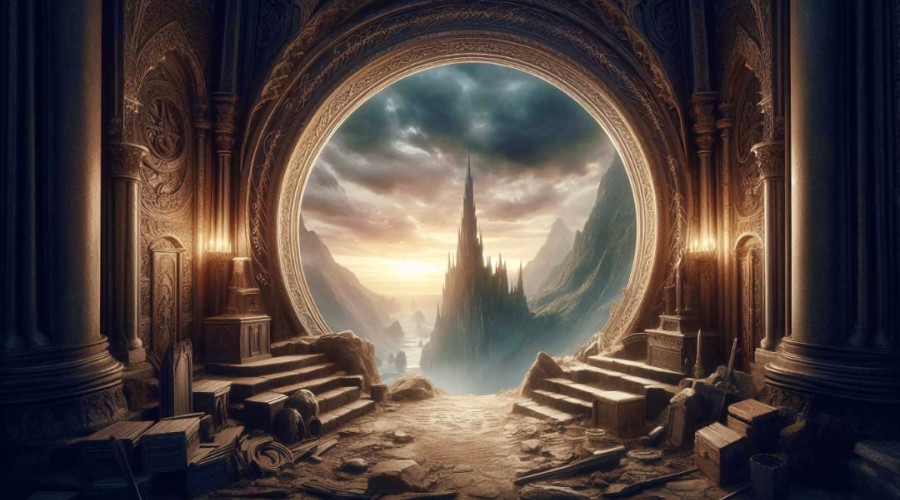
J.R.R. Tolkien’s “The Lord of the Rings” is not just a story about heroes, villains, and quests; it is also a tale deeply rooted in the setting of Middle-earth. This epic narrative's locations are as many characters as the hobbits, elves, and men who traverse them. In this blog, we’ll delve into the importance of these settings and their profound impact on the narrative.
In The Lord of the Rings, locations are more than mere settings; they reflect the characters’ inner journeys
The Shire: The Heart of Hobbiton
The journey begins in the Shire, the idyllic homeland of the hobbits. This pastoral paradise represents peace and simplicity, setting the tone for the entire saga. The Shire is not just a backdrop; it’s the emotional anchor for the characters, especially Frodo and Sam, who carry the memory of its green hills and tranquil life throughout their perilous journey. It symbolizes what they are fighting to preserve and return to, making every step away from it more poignant.
Rivendell: The Last Homely House East of the Sea
Rivendell serves as a sanctuary and a place of rest for weary travellers. Its ethereal beauty and ancient wisdom stand in stark contrast to the world's growing darkness. Here, the Fellowship is formed, and the quest truly begins. Rivendell represents the old world that is fading away and the last stronghold of peace before the wilds of Middle-earth.
Moria: The Darkness Beneath the Mountains
The mines of Moria present a stark shift from the beauty of Rivendell. This once-great dwarven kingdom, now a tomb, reminds the characters of the consequences of greed and the impermanence of even the mightiest civilizations. The darkness of Moria is not just physical but symbolic, forcing them to confront their fears and the reality of their quest.
Lothlórien: The Golden Wood
Lothlórien is a sharp contrast to Moria, a place of otherworldly beauty and ancient magic. It is a haven of the elves, untouched by time, representing an uncorrupted beauty that seems almost out of reach in the face of the encroaching darkness. The gifts the Fellowship receives here are not just tools but symbols of hope and resilience.
Mordor: The Land of Shadow
Mordor, the ultimate destination of the Fellowship’s quest, is the embodiment of evil in Middle-earth. Its barren landscapes, volcanic fires, and the ever-watchful eye of Sauron make it a land of despair and fear. The very land opposes those who enter, making the final steps of the quest the most gruelling. Mordor is not just a place but a force, representing the overwhelming power of the enemy
Each location in Tolkien’s world is meticulously crafted to reflect the themes and emotions of the story, making Middle-earth a rich tapestry of interconnected narratives and histories.
In addition to the locations already discussed, here are some other significant places in “The Lord of the Rings”:
- The Mines of Moria: Once a thriving Dwarven city, Moria is now a place of darkness and danger, highlighting the theme of decay and the passage of time.
- Isengard: The stronghold of Saruman becomes a symbol of industrialization and the despoiling of nature, contrasting with the more idyllic settings like the Shire.
- Helm’s Deep: The site of a major battle, it represents the resilience and courage of the defenders against overwhelming odds.
- Gondor: The last kingdom of men, standing as a beacon of hope against the darkness of Mordor.
- The Dead Marshes is a haunting landscape that reminds visitors of past battles and the lingering effects of war.
In The Lord of the Rings, locations are more than mere settings; they reflect the characters’ inner journeys and the overarching themes of the saga. They shape the narrative, challenge the characters, and reflect the broader conflict between good and evil. Middle-earth, in all its diversity, is a character in its own right, and understanding its significance is key to grasping the depth of Tolkien’s masterpiece.
Tolkien’s meticulous crafting of Middle-earth’s geography serves not only as a testament to his world-building prowess but also as a narrative device that enriches the story. Each location is carefully chosen and described to reflect the mood, the stakes, and the evolution of the characters’ journey. As we unveil the layers of Middle-earth, we uncover the genius of Tolkien’s storytelling and the timeless appeal of his created world.




